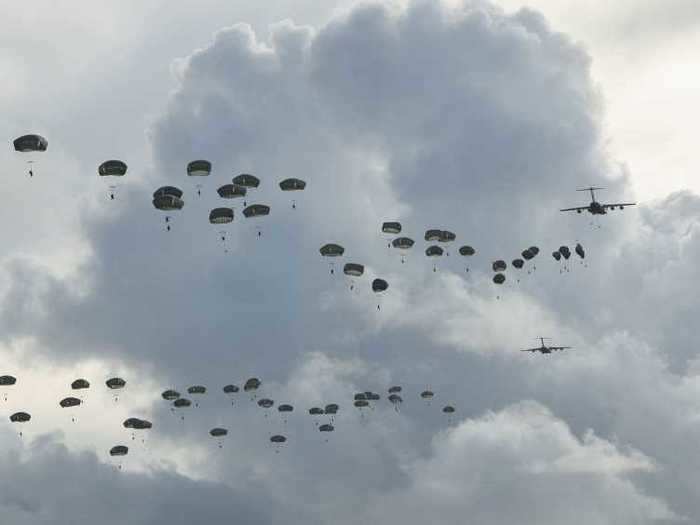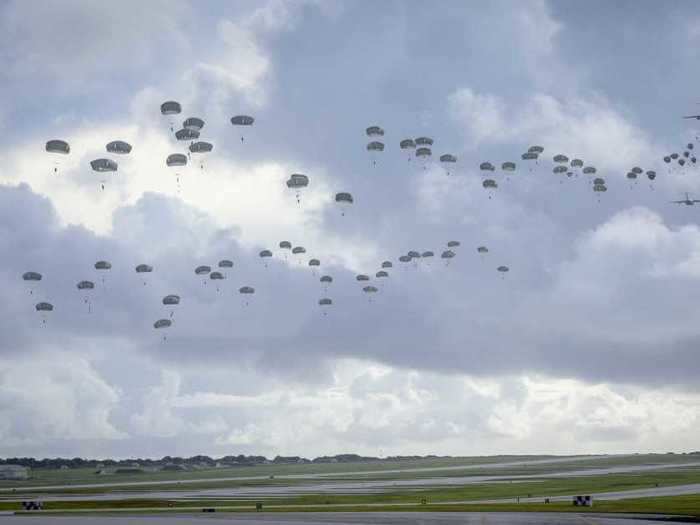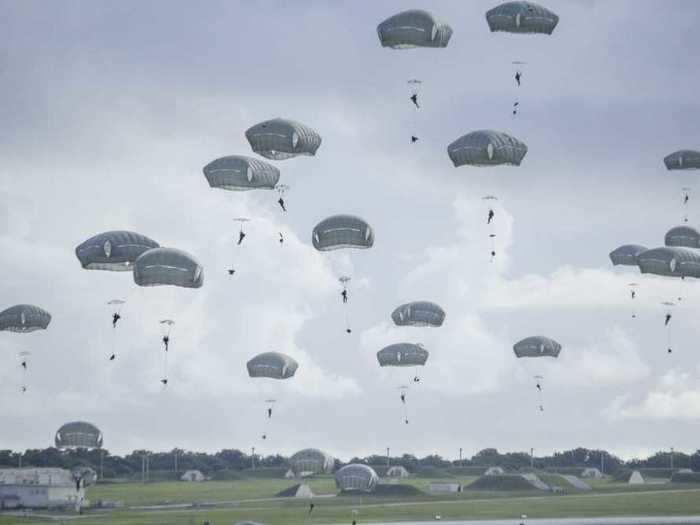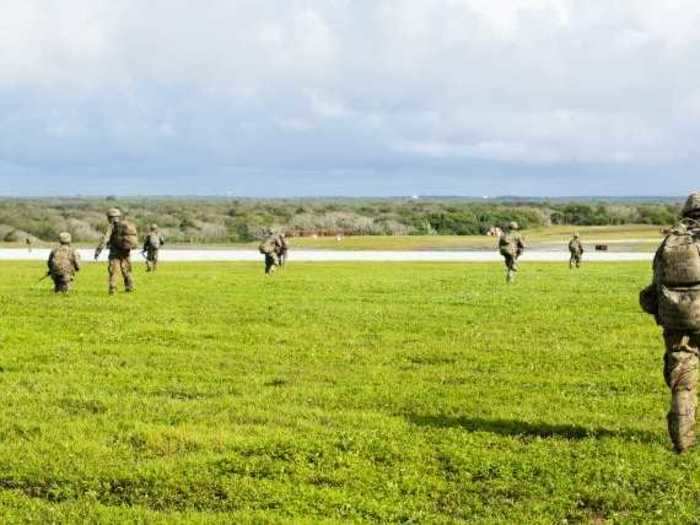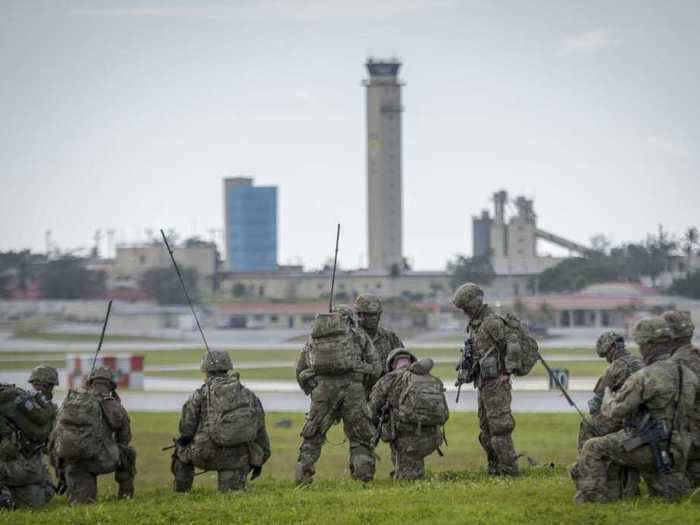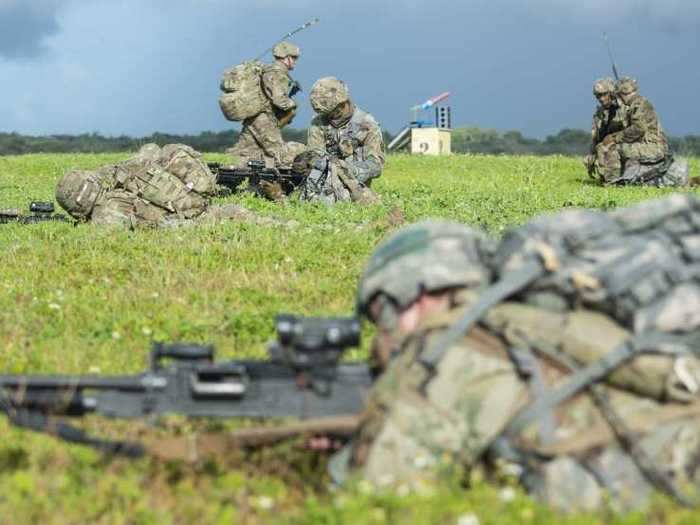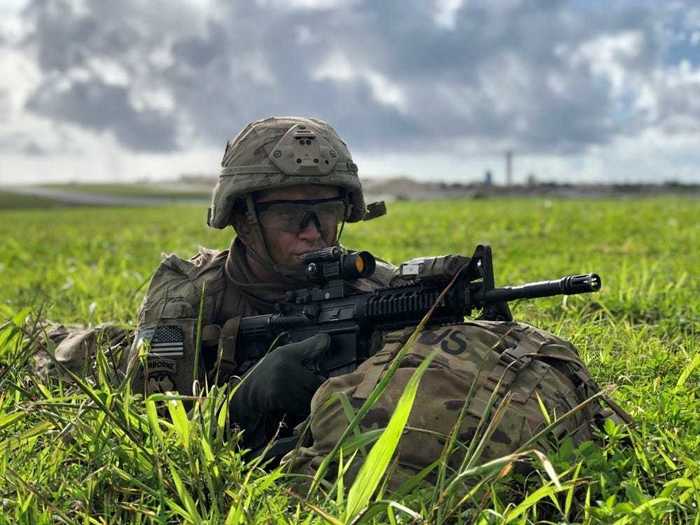Paratroopers of the 4th Infantry Brigade Combat Team (Airborne), 25th Infantry Division, U.S. Army Alaska, demonstrate a joint forcible entry into Andersen Air Force Base, Guam, June 30U.S. Air Force photo by Staff Sgt. Divine Cox
- US Army Alaska airborne troops flew from Alaska to Guam, where they jumped Tuesday and seized control of the airfield at Andersen Air Force Base in a mock invasion.
- The exercise comes amid tensions with rival powers and as the US military attempts to demonstrate its ability to project power at great distances, something it has been doing with bombers and aircraft carriers.
- These images show how the mock invasion went down.
Hundreds of US Army paratroopers practiced launching a long-range invasion of a Pacific island on Tuesday as the US military flexes its muscles in the region.
Here's what it looked like.
US Army airborne troops flew nearly 5,000 miles to execute a mock invasion of Guam.
US Army paratroopers jump over Guam from US Air Force C-17 airlift planes
U.S. Air Force photo by Master Sgt. Richard Ebensberger
Over 400 paratroopers flew from Joint Base Elmendorf-Richardson in Alaska to Andersen Air Force Base in Guam, where the soldiers jumped and practiced seizing an airfield, which would clear the way for follow-on forces in a real combat situation.
US Army Alaska called it the exercise, which appears to be part of the Department of Defense's ongoing efforts to master modern expeditionary warfare tactics for possible combat in the Pacific theater, the "largest airborne operation here in recent memory."
The paratroopers flew in US Air Force C-17 Globemaster III transport aircraft, gearing up for the jump en route.
US Army paratroopers jump over Guam
U.S. Air Force photo by Staff Sgt. Divine Cox
The participating airborne troops are part of the 4th Infantry Brigade Combat Team (Airborne), 25th Infantry Division of US Army Alaska, the Army's only Pacific airborne brigade able to deploy rapidly anywhere in the world.
The airborne troops that jumped into Guam were only given a few days notice to simulate a real invasion scenario.
Paratroopers descend on Andersen Air Force Base in Guam
U.S. Air Force photo by Staff Sgt. Divine Cox
The "scenario tested our ability to execute real-world missions and demonstrated that we are capable of deploying anywhere in the US Indo-Pacific Command area at a moment's notice," Col. Christopher Landers, the commander of US Army Alaska's 4-25 IBCT(A), explained in a release.
US paratroopers at Andersen Air Force Base
U.S. Air Force photo by Senior Airman Michael S. Murphy
The invasion drill, part of ongoing exercises in the Marianas, comes amid tensions with China in strategic airspace and waterways and as the US attempts to demonstrate its ability to project power in a clear message to rivals.
US paratroopers at Andersen
U.S. Air Force photo by Staff Sgt. Divine Cox
China has constructed military outposts, including some with operational airfields that have at times hosted fighters and bombers, across the disputed South China Sea, a contested waterway where the US and Chinese militaries have had some "risky" run-ins in recent months.
The US demonstrated reach with synchronized flights through Europe and the Pacific in May with US-based B-52H Stratofortress and B-2 Spirit bombers.
US paratroopers at Andersen
U.S. Air Force photo by Senior Airman Michael S. Murphy
STRATCOM said at the time that the "dynamic employment" of these long-range bombers "showcased the United States' ability to conduct synchronized strategic deterrence anywhere in the world with a ready, lethal force."
US-based bombers have been flying regularly over Europe and the Pacific in recent months.
And, as another demonstration of US military power projection capabilities, the US Navy has three carrier strike groups in the Pacific, where the service just conducted back-to-back dual carrier operations in a week.
A US paratrooper at Andersen
U.S. Air Force photo by Master Sgt. Richard Ebensberger
"Dual carrier operations," one strike group commander said, "demonstrate our commitment to regional allies, our ability to rapidly mass combat power in the Indo-Pacific, and our readiness to confront all those who challenge international norms that support regional stability."

